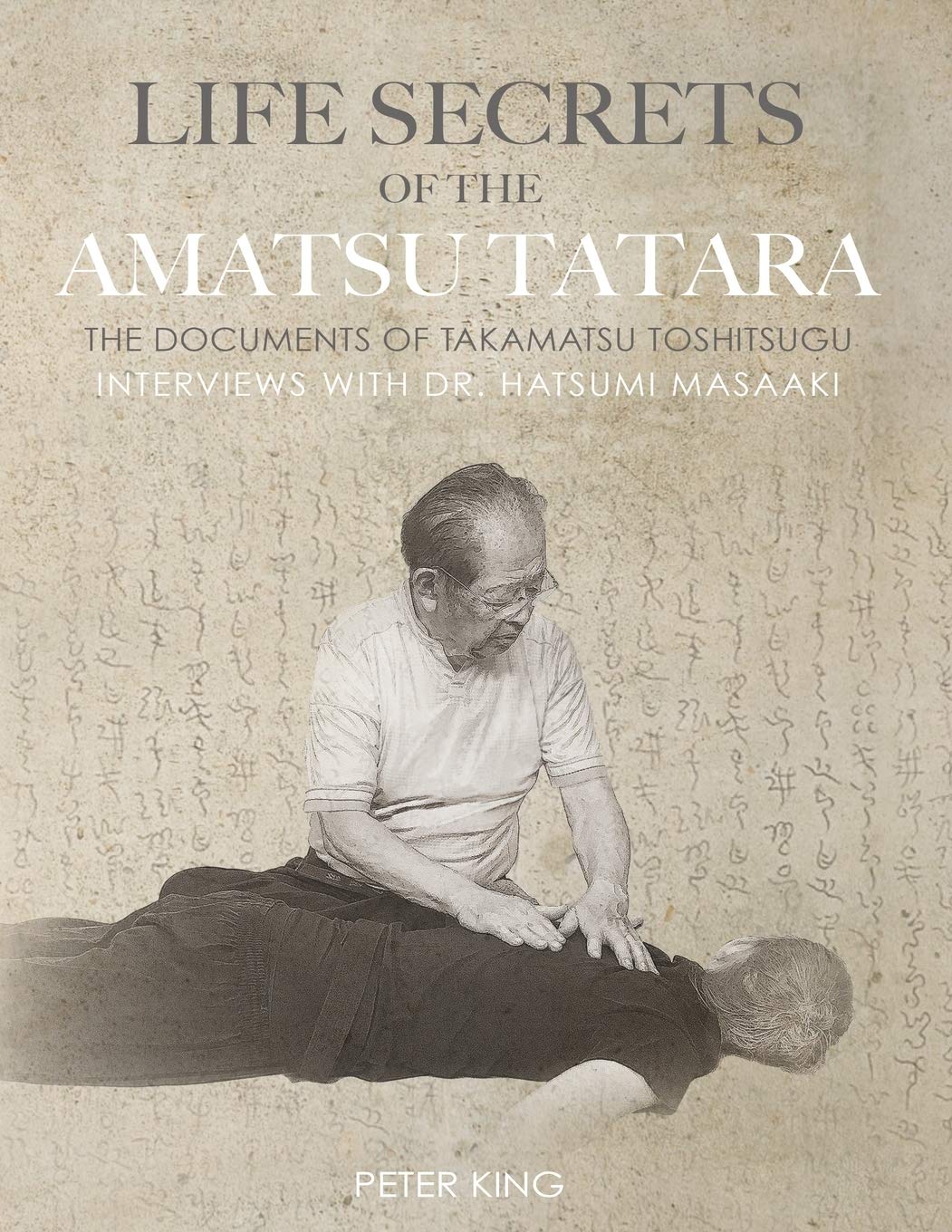Ima Ninja いま忍者 (Contemporary Ninja)
Ko no Chiteki Henshinjutsu この知的変身術 (Their Intelligent Art of Metamorphosis)
Ninpō Used in Daily Life
Introduction
Here is my ongoing translation work from chapter 5 of Hatsumi Sensei’s book: Ima Ninja いま忍者 (Contemporary Ninja) Ko no Chiteki Henshinjutsu この知的変身術 (Their Intelligent Art of Metamorphosis).
As I finish translating more sections from this chapter I will add them to this post so they are all in one place in proper order for people to then read and share. Please share my post directly from my dojo website and do not copy it to your own page. If you copy the contents of this note you will miss future additions and corrections I make to the translation.
NOTE: If you wish to translate my English translation of Chapter 5 into your own language please contact me so we can work together to be sure you stay updated with the current version I have released here.
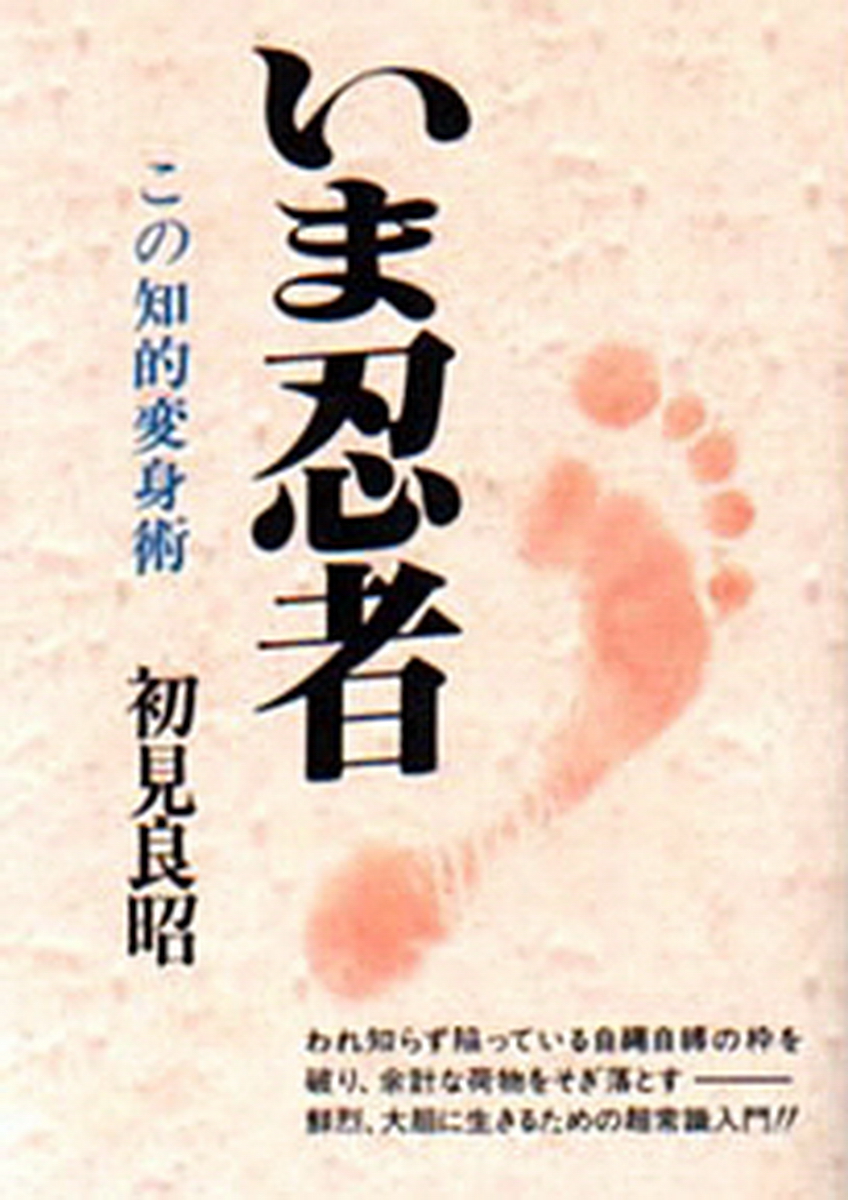
Chapter 5 Translation
Chapter 5 of this book contains various aspects of how to maintain your health in your daily life and recover from disease utilizing the natural methods of the Hichibuku Goshinjutsu 秘致武九護身術. There are very important points expressed in this chapter on how various diseases “come down through us” that Hatsumi Sensei explains. Also, methods to systematically remove these diseases by natural means. Hatsumi Sensei explains that Takamatsu Sensei taught him that above all three factors are important to maintaining our health:
- Tadashī Seishin 正しい精神 (correct spirit)
- Eiyō 栄養 (nutrition)
- Undō 運動 (movement exercises)
NOTE: The treatment portion (Do it Quietly and Slowly) in Section III of Chapter 5 follows closely to the contents of the document: Hichibuku Goshinjutsu Genri 秘致武九護身術原理 which is contained within the larger document: (Nakatomi) Tatara Hibun 蹈鞴秘文.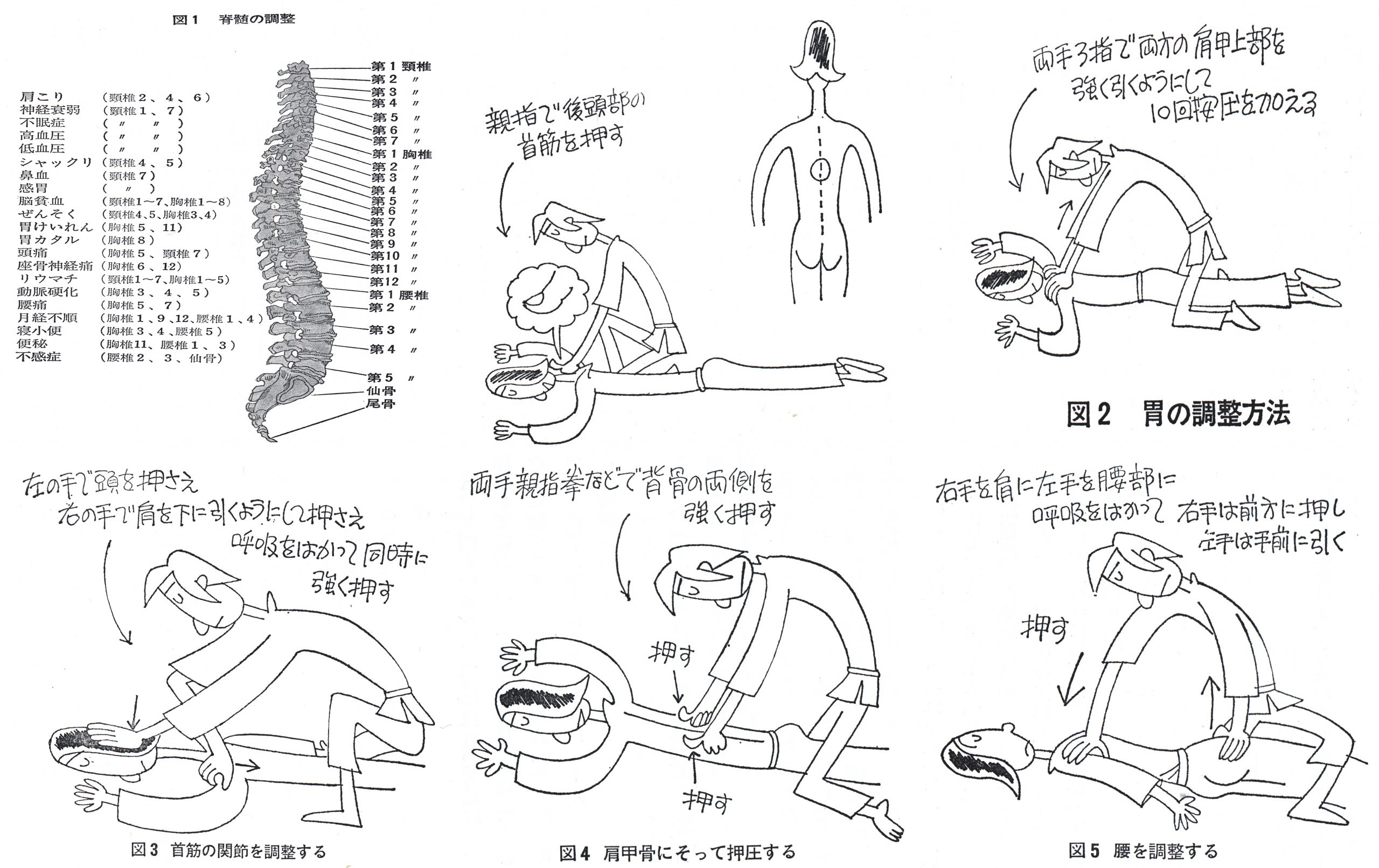
~ DISCLAIMER ~
- First, the effectiveness of the treatment methods related to cancer in this chapter are not proven to date by modern scientific study or findings. One should always follow the treatment recommendations by their doctor.
- Second, this text is by no means a way to begin practicing the Hichibuku Goshinjutsu as a therapy on other people. It is not a replacement for the proper training required.
- Third, anyone falsely representing themselves as a practitioner of Hichibuku Goshinjutsu without the proper training and certification approved by Hatsumi Sensei is shameful. My release of this chapter in English is for reference and educational purposes only.
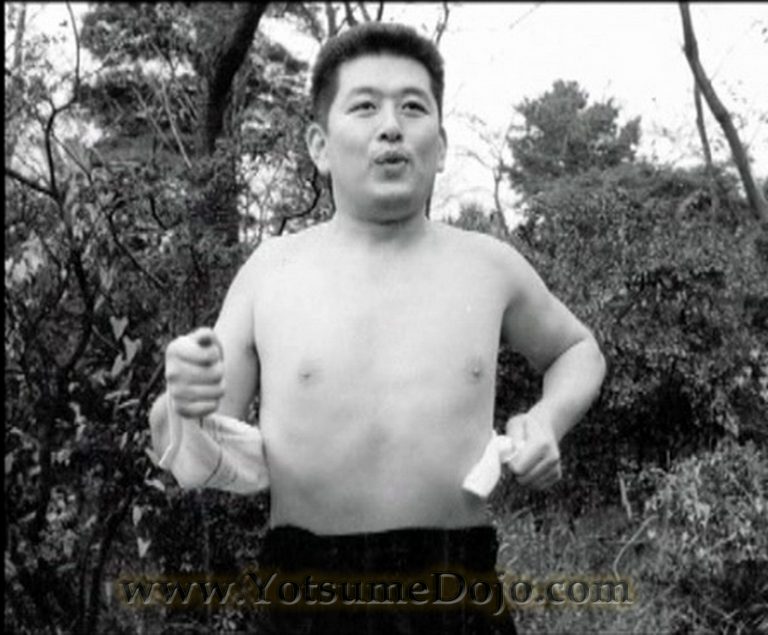
Chapter 5
Ninpō Used in Daily Life
Kurashi no Naka no Ninpō
暮しの中の忍法
~ Table of Contents ~
SECTION I – Food is a Natural Medicine 食は生薬 Shoku wa Shōyaku
- Pg 194 – What is Being Healthy?
健康って何だろう Kenkō te nanidarou? - Pg 198 – Rōjō Shoku is a Beautiful Diet
籠城食は美容食 Rōjō Shoku wa Biyō Shoku - Pg 201 – The Ninja Diet That Cures Cancer
ガンを治す忍者食 Gan o naosu Ninja Shoku - Pg 203 – What to Eat and In What Way
何をどう食べればよいか Nani o dō tabereba yoi ka
SECTION II – Ninpō Protects You From Accidents 事故から身を守る忍法 Jiko kara Miwomamoru Ninpō
- Pg 206 – A Single Rope Saves Lives
一本の縄が命を救う Ippon no nawa ga inochi o sukū - Pg 209 – An Instinct That Helps Us Judge the Situation
状況を判断するカンを養う Jōkyō o handan suru kan o yashinau
SECTION III – A Healthy Method for All 誰でもできる忍者流健康作戦 Daredemo dekiru ninja-ryū kenkō sakusen
- Pg 213 – Three Views of Foot Massage
三本足ムッサージ Sanbon Ashi Massāji - Pg 215 – Revealing the Highest Secret
最高の秘伝を開する Saikō no Hiden o ake suru - Pg 216 – First Purify the Blood
まず血液を浄化する Mazu ketsueki o jōka suru - Pg 218 – Do it Quietly and Slowly
静かにゆっくりと行う Shizuka ni Yukkuri to Okonau - Pg 227 – Self-Defense That Can Be Done Alone
一人でできる護身術 Hitori de dekiru Goshinjutsu
SECTION III
Sanbon Ashi Massāji 三本足マッサージ
(Three Views of Foot Massage)
TRANSLATION NOTES:
Here is my translation of pages 213-215. This article from the book covers a number of points that are from the foot diagnosis method known as: Kanshi Hō 観趾法. I have included a photo of an old manuscript in my personal library that explains the same points Hatsumi Sensei is making in his article on the subject. There is some great daily health maintenance advise given here!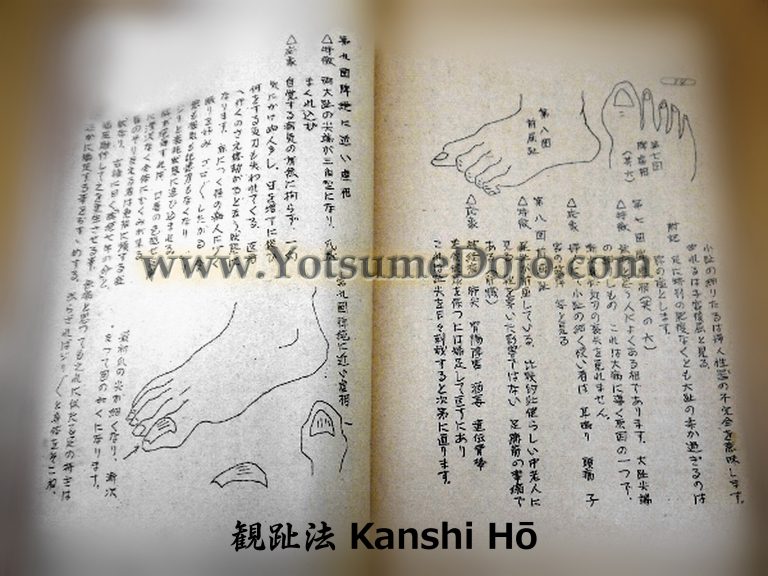
“Bugeisha had a peculiar way of massaging and rehabilitating their bodies. On the basis of this, I would like to comment on something very basic that not many people know. When the five toes are perfectly aligned, people usually think that this is a sign of good health. However, there are small details that help us to understand what our bodies are trying to tell us. When a toe is shorter than the rest, it usually is a purple color or simply just different to the rest, the body is not telling us that it does not function, for example, when the big toe is enlarged in comparison to the rest we could conclude that our liver is working excessively. It is also a bad sign, to find twisted or wrinkly toes. These such toes generally, are thinner, and that there is some sort of functional disorder.”
“People that snore usually have a big toe that is lifted more than the rest. A good cure for this is to squeeze this toe inside a fist and move it in a circular motion, pressing and loosening the pressure, in a few days the snoring will stop. To those people that have an elevated big toe and in some cases where the nail is falling off, I advise them to be vigilant as these are symptoms of people who have a tendency to get liver disease. The role of the liver is to rid our body of impurities and we must not forget that it is a vital part of our organism. When the liver deteriorates it affects all the internal organs that one by one develop some sort of illness. In the first moments the person experiences a great sense of irritability, insecurity and distrust which give the impression of a dis-likable character. Following on from the toes, when the big toe is extremely skinny and very wrinkly or also when the nail appears extremely split we could assume that the pancreas is not functioning well.”
“Another method of relieving the same problem is to press the toe and if after several seconds of loosening the pressure there are still wrinkles, there is definitely a problem with the pancreas. In this case, if the person experiences exhaustion, one could say that they easily contract illnesses by simple physical contact. I have also seen people who have had problems with their sight. In whichever way, given the previous symptoms of the toes, it seems probable that they will contract cirrhosis of the liver. I recommend to these people to earnestly accustom themselves to massaging their toes daily. If they continue to do this, they will lose excess weight, improve their condition and also reinforce their own immune system. When we have a healthy liver and pancreas we have a greater immunity to the common cold and other contagious illnesses. In the ancient texts there are stories of the ninjas massaging their toes daily. This not only improved circulation but relieved exhaustion and at the same time repaired the body and predicted possible illnesses. They also include data about men massaging their big toes. They used to turn the big toe side to side, ninety nine times every day. It is also said that it helped them to maintain a longer and more pleasurable sex life. For the ninja, the health and well-being or the family were very important aspects.”
“Without including anything too personal, I can assure you that my daily walk of three hours has never done me any harm, a lengthy walk with short, tranquil stride and without rushing. It is said, that running is healthy, but my advice to the young people and everyone healthy is not to do this. Walking peacefully, taking in the sun and fresh air are sufficient elements to help maintain good health without too much effort.”
SECTION III
Saikō no Hiden o ake suru
最高の秘伝を開する
(Revealing the Highest Secret)
TRANSLATION NOTES:
Here is my translation of page 215. This is an introduction by Hatsumi Sensei to the third section of the book covering the health methods, observation skills, and two person treatment protocols.“The primary point of being healthy is that the spine (Sebone 背骨) and legs are strong/sturdy. In order to maintain this, the Bugeisha 武云者 (practitioner of the martial arts) had been acquainted with Hichibuku Goshinjutsu 秘致武九護身術. Kyū 九 (nine) is a character conveying the highest meaning. This is done by two people (practitioner and subject), but even one person can apply this theory alone. Saiminjutsu 催眠術 (hypnotism) techniques, Seishin Ryōhō 精神療法 (psychotherapy), and Kokyūhō 呼吸法 (breathing methods) are the basis. It is a big feature that you can do this easily at work or at home. The following is what I was taught directly from Takamatsu Sensei.”
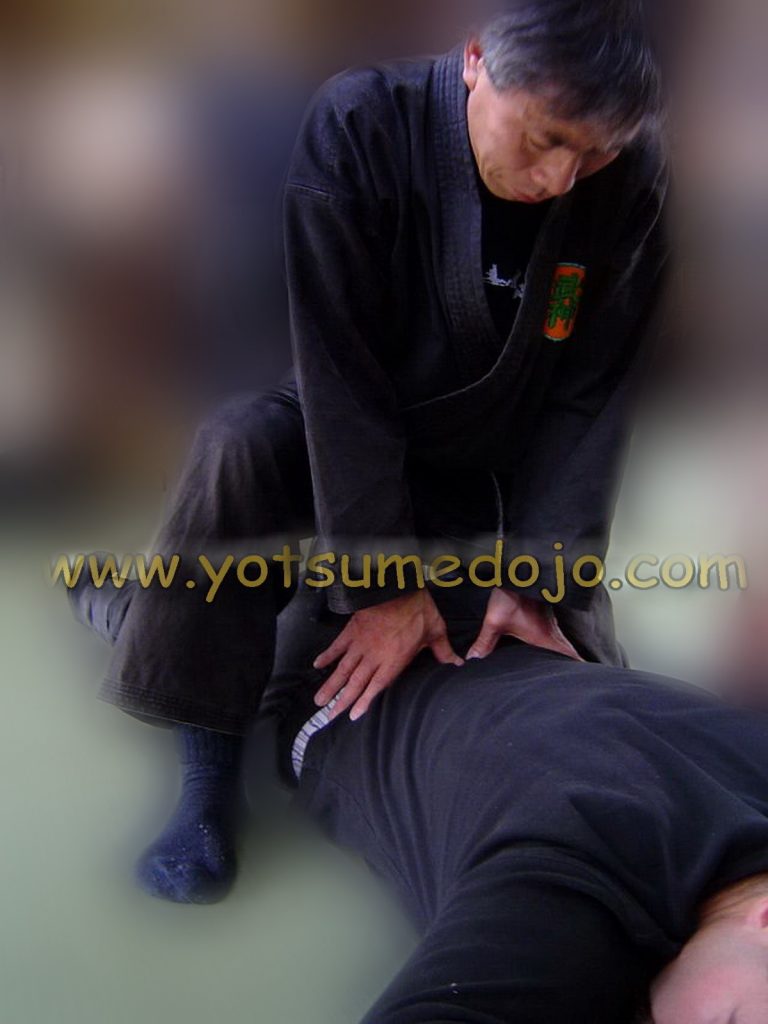
SECTION III
Mazu Ketsueki o jōka suru
まず血液を浄化する
(First Purify the Blood)
TRANSLATION NOTES:
Here is my translation of page 216. I have included a photo of the kanji for "Bonnō" 煩悩 (desires, attachments) because having an understanding of this teaching is critical to understanding this portion of what Hatsumi Sensei is expressing.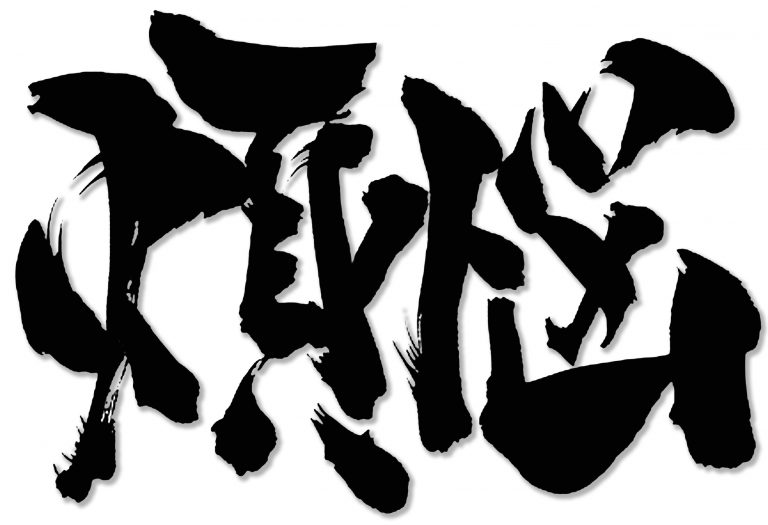
“Hichibuku Goshinjutsu 秘致武九護身術 does not use any medicine or equipment at all. It is an excellent technique that removes the Byōgen 病源 (source of disease) by improving the blood circulation where the Sejutsusha 施術者 (practitioner) moves their whole body freely without thought (Seishin Tenka 精神転化 – mental shift/transformation).” “Originally a disease comes from our spirit and the way our mind is held influences our body and circulation which causes obstacles.” “Buddhism preaches that there are 84 thousand Bonnō 煩悩 (desires, attachments) to human beings, falling into the valley of this anxiety makes it difficult to find relief both physically and mentally.”
NOTE: Bonnō is a function of the mind that brings trouble, passion, and illusion. Desires are natural; they become Bonnō when there is attachment.“For example, when a man wants to declare himself to a woman and he is not capable, the body reacts: the nervous system is stimulated in excess, the blood flows in reverse and the circulation is not adequate for the body as if the bones will break.” “When certain problems continually worry us, each worry “acidifies” (Sanseika 酸性化) our blood, affecting the “endocrine glands” (Bunpisen 分泌腺) and “digestive fluid” (Shōkaeki 消化液) causing loss of “appetite” (Shokuyoku 食欲).” “Although it is said if water is too clean it means fish cannot live, but you will not be able to live with sick blood. In order to cleanse the blood, we have to remove the defects/deficiencies of life one at a time.”
“To make the blood healthy three factors are important; Tadashī Seishin 正しい精神 (correct spirit), Eiyō 栄養 (nutrition), and Undō 運動 (movement exercise).” “There will be sickness if the blood itself becomes polluted causing the blood vessels to weaken and the circulation to get stuck.” “Depending on your weight the human body will have between 9 to 12 pints of blood.” “If you lose too much of your blood one can go into hypovolemic shock. You will experience mental confusion, possibly a stroke, and there is a risk of paralysis and a loss of use of the extremities. Also, permanent brain damage may occur.” “When blood circulation disorder occurs in the abdomen, disorders appear everywhere including the liver, kidney, and other gastrointestinal disorders such as Shōka Furyō 消化不良 (indigestion), Ikasui 胃下垂 (gastroptosis), Benpi 便秘 (constipation), and Geri 下痢 (diarrhea).” “If blood circulation becomes stagnant staying in one part of the body and begins to decay, it will cause abnormality in the whole of the blood circulation. That’s why when one body part is sick, the whole body loses its vibrancy and becomes uncomfortable.” “To clean the blood circulation there are medicines and injections which could help to a certain extent, but blood that is stagnant in the middle of a blood vessel these will not work in this situation.”
“Then there is no other means than to apply the therapy of Hichibukujutsu Goshinpō 秘致武九術護身法, because it is unnatural to put a scalpel and cut the person’s body.” “Shizen 自然 (nature) is the pride of the Ninja, which uses the law of justice instead of punishment. This method is characterized by purifying the spirit, eliminating obstacles in the circulation, and curing diseases from the root.”
SECTION III
Shizuka ni Yukkuri to Okonau
静かにゆっくりと行う
(Do It Quietly and Slowly)
TRANSLATION NOTES:
Here is my translation of the health method that begins of page 218 from Section 3 of Chapter 5. This article begins with 12 precautions or recommendations that one must follow when practicing this method.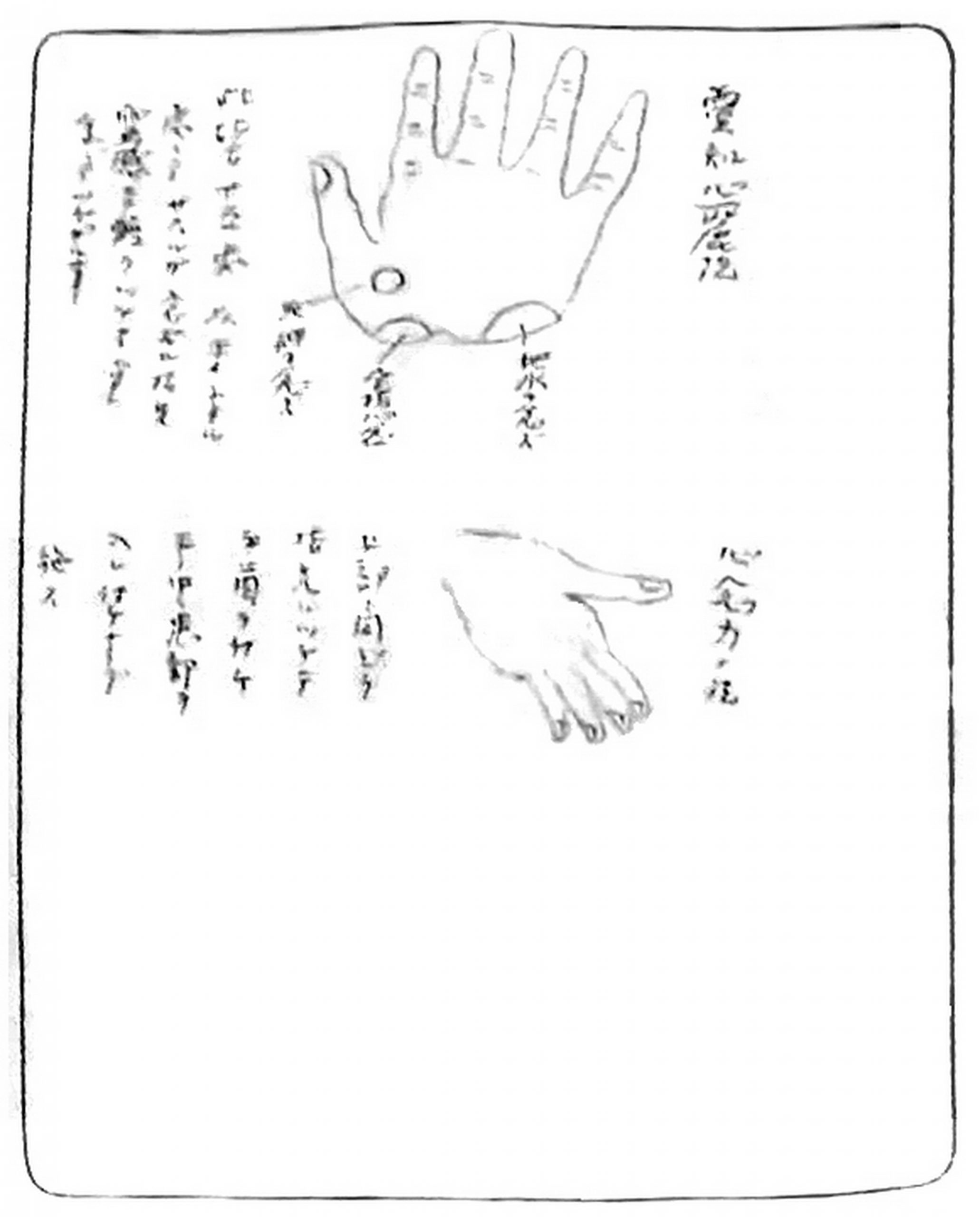
“This is a health method that anybody can do. I’m sure that your mother and father would love to receive it. However, never do these methods recklessly. Perform these methods quietly and slowly so that they feel good. It is important to apply these methods in a way that adjusts to each individual.”
“These are the important points you have to be cautious of when practicing”:
- The Jutsusha 術者 (practitioner) must clean their hands.
- The Kanja 患者 (patient) must relax themselves and leave their whole body to the practitioner.
- The Jutsusha must not practice these methods vigorously at first, practice them depending on the patients’ constitution. It is sufficient to apply them for 15 minutes.
- The Jutsusha needs to have the power to suggest upon the patient to some extent.
- The way you practice these methods is different depending on each illness; the illness that needs recovery from fatigue, maintenance of one’s health, chronic disease, or the illness that needs rest. The amount of force you put in is different as well.
- To calm the patient’s spirit, you can make the patient fold and unfold their fingers as they count.
- The Jutsusha must purify their heart and body, they must rid themselves of worldly thoughts. They must have a strong perseverance and endeavor that they will be able to rid the patient of their illness through this method.
- Before you practice this on a patient, you have to know the cause of their illness by checking their face and their spine. Ask them where they feel pain. Ask them if there are any marks from a surgery or a Moxa (moxibustion). Also ask them about other illnesses they had. After you know all this history, practice most carefully.
- If the patient seems to have a fever, do not practice this method on their whole body. Also, be careful about their diet.
- There is a method of Saiminjutsu 催眠術 (hypnotism) called Sokusan Ho 速算法 (fast calculation/divining method) where you make the patient count while you hit their lower limbs softly. Making the patient count makes them mesmerized and they will fall asleep comfortably.
- You should make allowances for the patients who have never had Shiatsu (finger pressures) or Anma (traditional massage). Make sure the patient feels comfortable at all times. This is a therapy for their spirit as well. Never make the patient endure their pain.
- The location of the source of their illness will be found when you keep practicing since it will be painful, because the blood will be stopped at this location. You should push and press around with your fist, five fingers, three fingers, thumb, or side of your hand. Treating only the source location of the illness is not enough since any part of the body’s damage can cause the whole body to become ill. You should apply this method to the their whole body. However, if it is a simple pain or a stiffness only from fatigue, then applying this method to that part only would be enough.
TRANSLATION NOTES:
This second portion of the article "Do It Quietly and Slowly" covers 9 sections of massage treatment. The last section covers a few treatments for three common ailments: Kōketsuatsu-shō 高血圧症 (High Blood Pressure), Shinkeitsū 神経痛 (Neuralgia), and Yōtsū 腰痛 (Backache). There are a few illustrated charts included in this section. The described techniques are common in both the arts of Shiatsu 指圧 (finger pressure therapy) and Anma 按摩 (traditional massage).NOTE: The following treatment protocol follows closely to the contents of the document: Hichibuku Goshinjutsu Genri 秘致武九護身術原理 which is contained within the larger document: (Nakatomi) Tatara Hibun 蹈鞴秘文.Treatment Outline:
- Adjustment of the Spine (CORRECTED)
- Stomach (not corrected yet)
- Neck (not corrected yet)
- Back (not corrected yet)
- Both Legs (not corrected yet)
- Toes (not corrected yet)
- Regulation of the Waist (not corrected yet)
- Abdomen (not corrected yet)
- High Blood Pressure, Neuralgia, and Backache (CORRECTED)
1. Adjustment of the Spine
Every illness is associated with abnormalities of the spine. Its position can be adjusted to affect a change by tapping the patient lightly about 100 to 150 times with the patient lying face down.
You can cure the impediment of blood circulation mainly by pressing around the 12th and 13th vertebrae on the spine with your thumbs, and by striking the area softly with Shutō (the side of your palm).
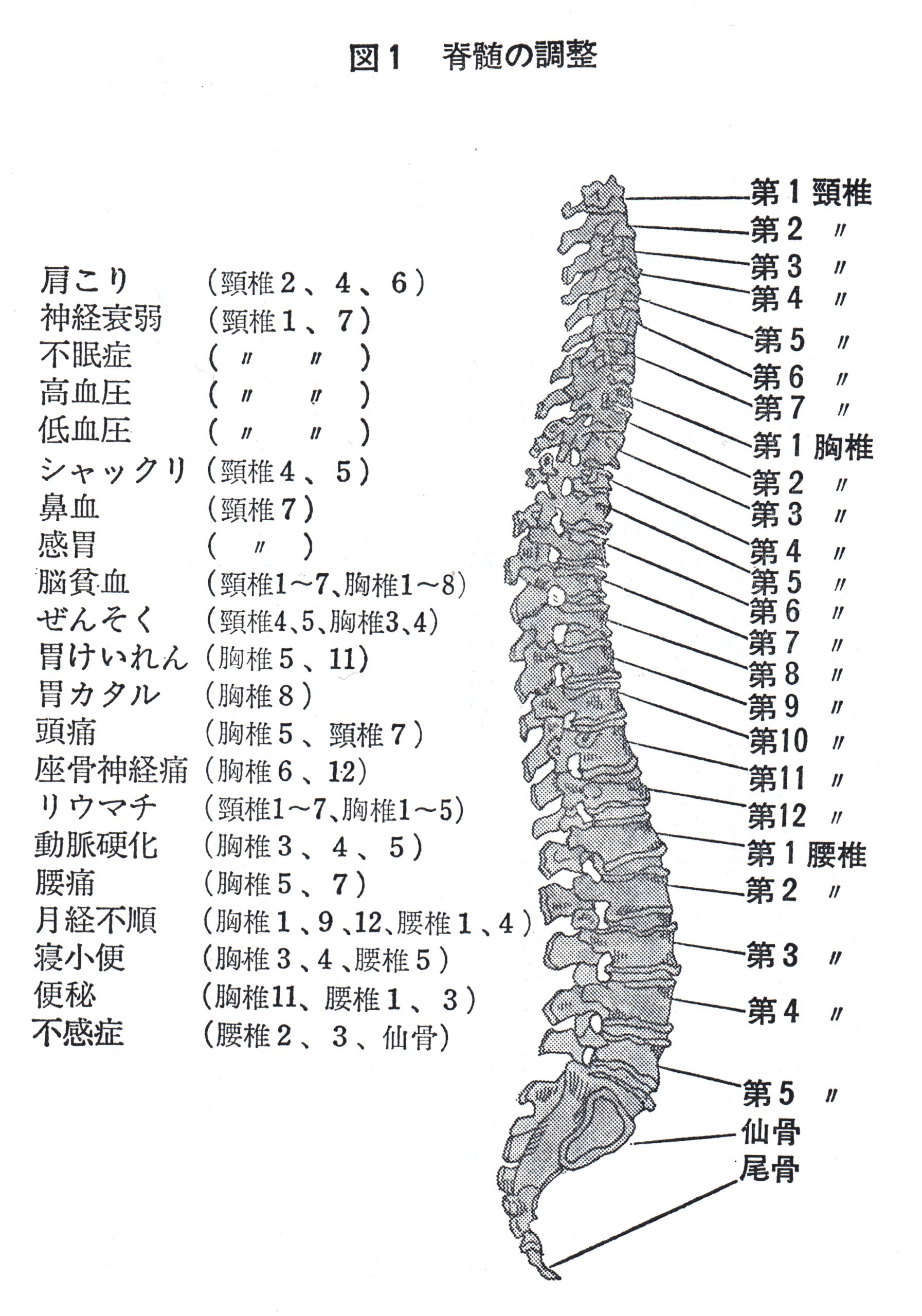
2. Stomach
If the patient has a problem with their stomach it means that the 5th and 10th spinal segments of the thoracic vertebrae are protruding (see illustration #2). If it is chronic, then you should also add the method to treat the abdomen (with Anpuku). Regulate the upper part of the spine just by hitting there gently. You should press the muscles on both sides approximately 3 centimeters from the spine with your thumbs or with the sides of your hands.
Have the patient lie down on a futon on their stomach in the most comfortable way with their arms stretched out (see illustration #2). The Jutsusha squats down on either the right side or the left side of the patient’s head with your thumb for about a minute then gently twist the head around. Do not let your nails grow claw-like. During the summer especially, wipe where you are going to be working on the patient with a towel soaked in mint water.
Next kneel down next to the patient’s back with your knees on the ground and press the Kenkōkotsu 肩甲骨 (scapula bone of the shoulder) with three fingers on both hands for 10 times, as if you were pushing.
Then find the indentation of the base of the neck with your middle finger and turn the artery and vein to the right and to the left lightly for about 20 times. When you are finished, raise both of the patient’s arms from the ground and gently replace them.
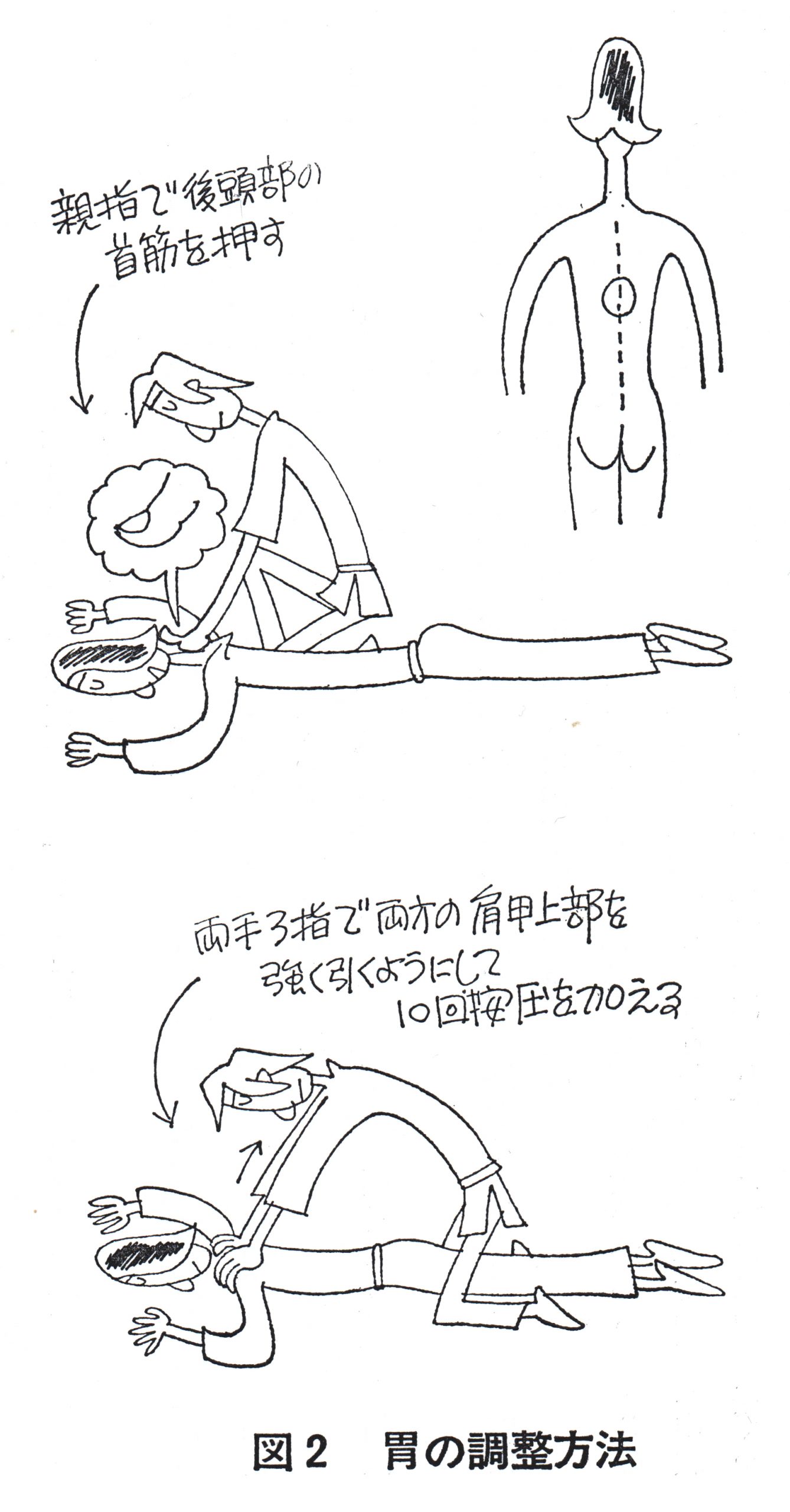
3. Neck
The regulation of the joint of the neck (scruff of the neck) is the main point of this method and it is the most effective. Have the patient lie down on the futon with their chin down, left arm up and right arm alongside their body (see illustration #3). The Jutsusha gets themselves in a half sitting position on the patient’s back and holds the patient’s head with your left hand while holding the patient’s shoulder with your right hand. Take a breath, then push both of your hands as you exhale in one slow breath and the neck will loosen (it will pop), the joint will be adjusted. Do it on the other side too. This will get rid of the stiffness in the shoulder area immediately.
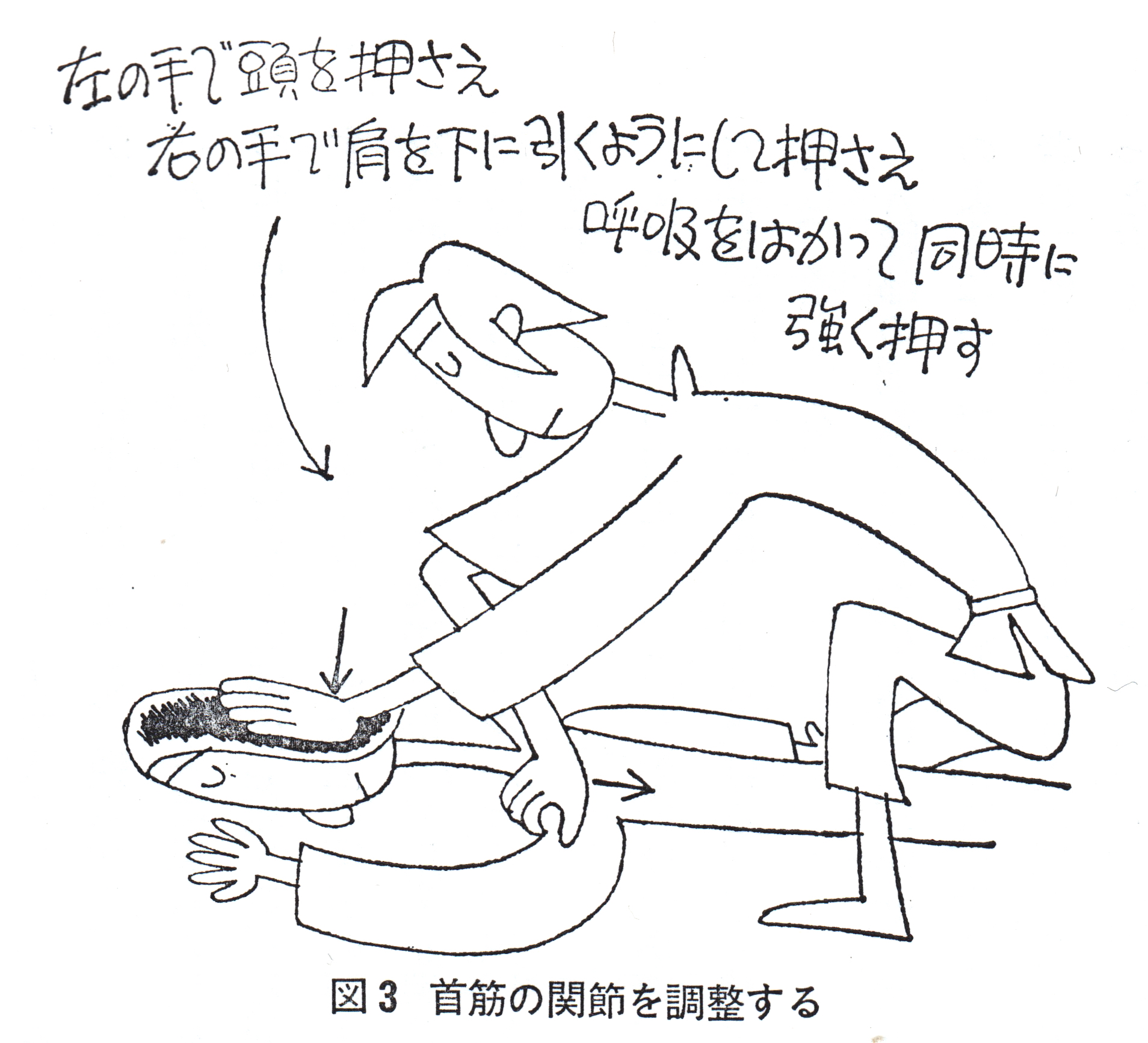
(Fig. 3 Adjust the Joint of the Neck)
4. Back
The Justsusha squats down on the patient’s back (see illustration #4) and presses on both sides of the 5th and 6th points of the spine really hard. Hit the muscles on both sides of the spine about 1000 times, then hit with both hands forcing your weight about 10 times. Then press with your fist a couple of times.
Next bring the patient’s left arm to the back until it hurts (with palms facing out). Then press along the Kenkōkotsu 肩甲骨 (scapula bone of the shoulder) with your right thumb. You do this 5 or 6 times from the shoulder down and do the same thing on the other side.
Next, you have the patient lie down on their stomach with their left leg bent like a frog creeping. The Jutsusha pushes their own left leg so the patient’s thigh touches his stomach, while pressing the patient’s right Daidenbu (side of hip) with your own right leg re-enforcing your weight. You repeat this about 10 times and do the opposite side too.
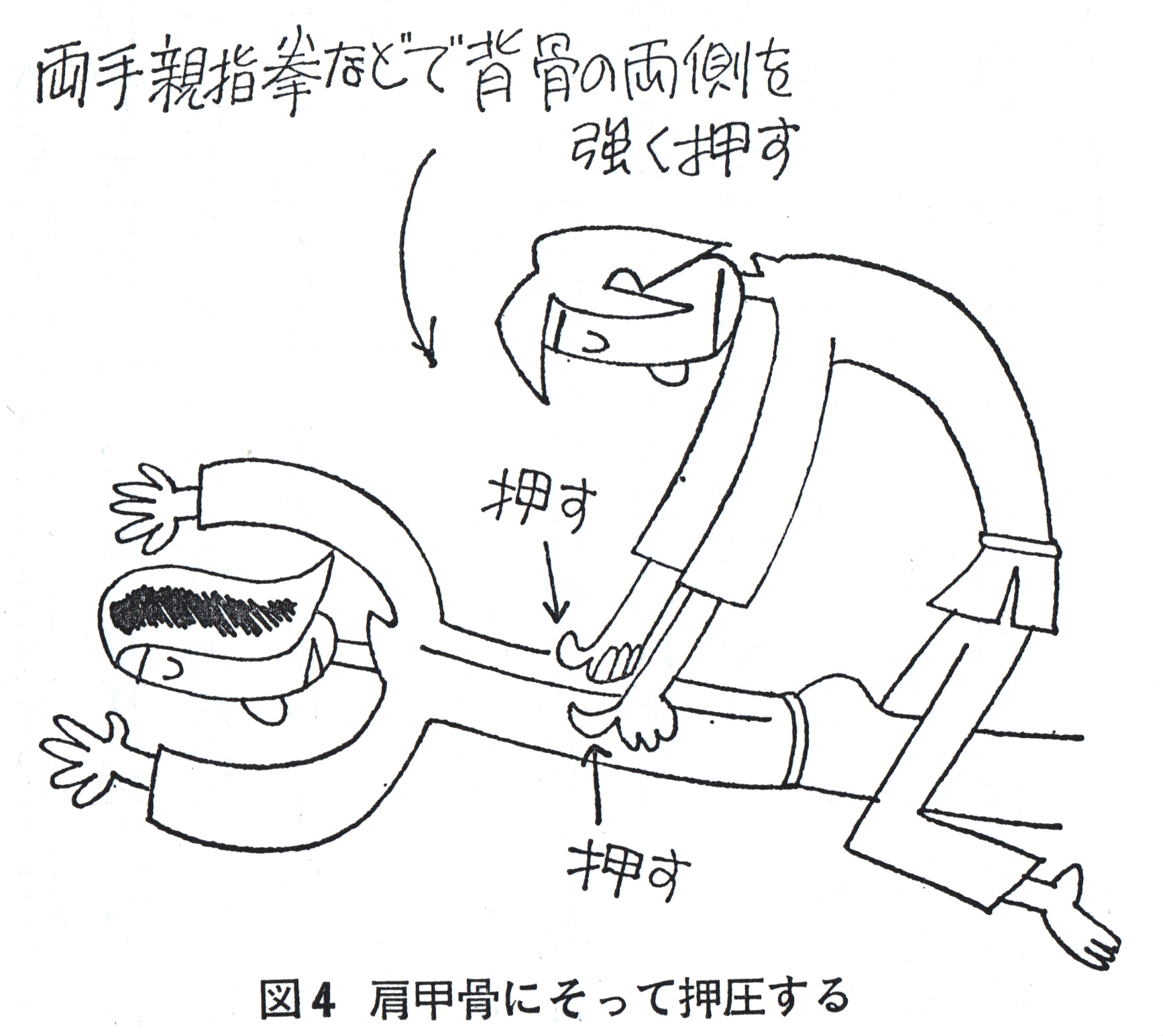
(Fig. 4 Press Along the Shoulder Scapula)
5. Both Legs
Have the patient lie down on their stomach and the Jutsusha sits down on the patient’s right side. You press the patient’s leg from thigh to their ankle with the side of your left hand about 10 times. Do the other leg too.
6. Toes
The Jutsusha puts the patient’s leg on your lap and then turns the patient’s ankles and toes around in a circle about 15 times for each toe. Next, have the patient put the back of their feet together and put both of your hands on them. Then with your knees together, toes facing their hip, apply your weight. Repeat this 3 times.
Next, the Jutsusha pulls up the patient’s right leg with their left arm and pulls up more with their right hand touching the patient’s waist. Repeat this twice and do the patient’s other side too.
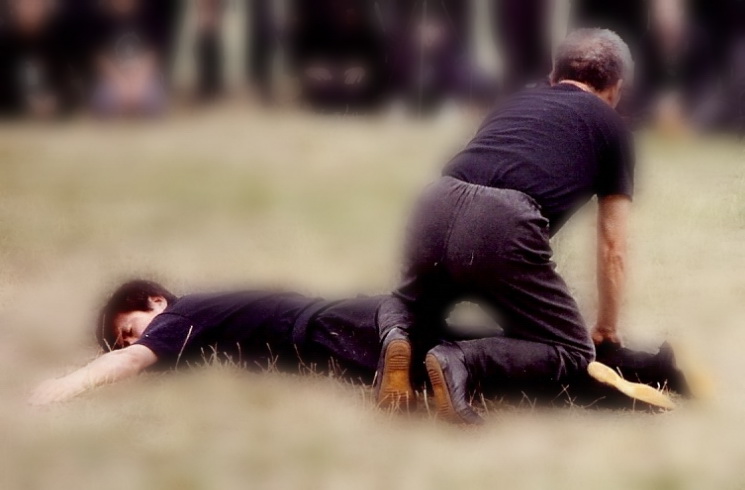
7. Regulation of the Waist
Have the patient lie down on their side and press their shoulder from the front with your right hand and their hip from the back with your left hand (see illustration #5) while they control their breathing. Push your right hand forward and left hand backwards with a tug. Do this for both the right and left sides.
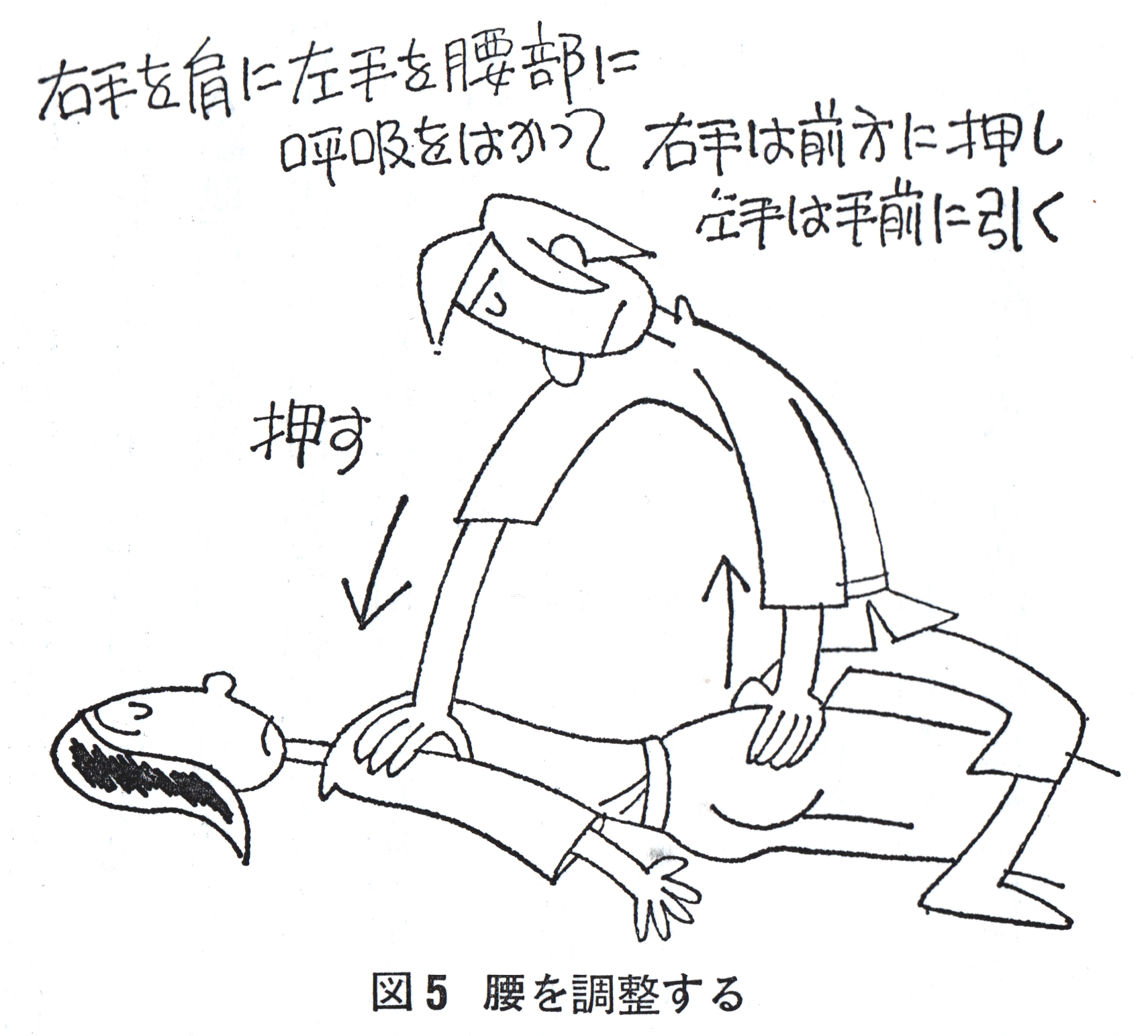
8. Abdomen
Have the patient lie down on their back and squat down on their right side. Inserting your left fingers into the patient’s right Jokotsu, press around the liver area about 30 times. Next do the same thing to the stomach and Kizobō on the other side. Press lightly from the stomach to the navel about 10 times with three fingers. If there is a place where it hurts the patient, that is the source of illness, so press until the pain is relieved.
Next have the patient lie down on his back with both of his knees bent and from the side press around his whole intestine area with both of your hands for about 5 times. You repeat this to the place at which there is pain for about 30 times. Massage from the navel.
Then have the patient straighten his legs and the Jutsusha squats down near the bottom of his legs. Push softly from the navel and up with both of your hands for about 30 times. Do this also to the lower abdomen.
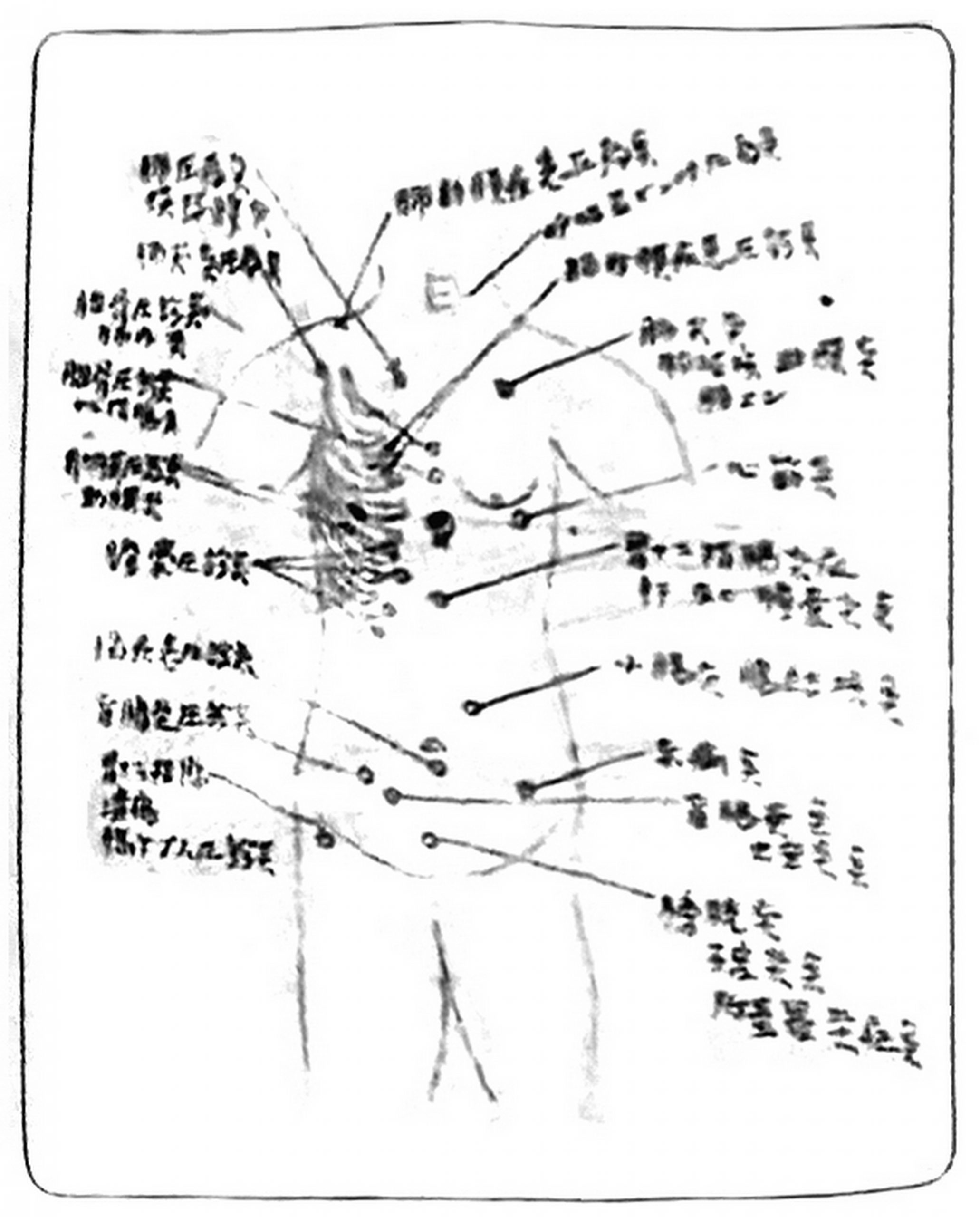
9. Kōketsuatsu-shō 高血圧症 (High Blood Pressure),
Shinkeitsū 神経痛 (Neuralgia), and Yōtsū 腰痛 (Backache)
- Have the patient pull their legs into their abdomen and the Jutsusha pushes their legs really hard 3 times with all your weight. Then hold the patient’s legs in your arm and push them around 3 times with all your strength as if you are turning a hand mill.
- Have the patient sit with their legs and arms stretched out forward. The Jutsusha clasps the patient’s abdomen with both hands from behind and then pushes it as if leaning upon the patient with all your weight, so that they can touch their toes. Repeat this 5 times calmly. The Jutsusha holds the patient’s shins from the back and then does the same thing a couple of times without straining.
- In the same way, have the patient cross their hands and you grasp their left wrist with your right and grasp their right wrist with your left hand from behind their back. Then put your shins against their back and pull backward. Move your shins from their waist up to the bottom of their Kenkōkotsu 肩甲骨 (scapula bone of the shoulder) and repeat this twice.
- Have the patient sit upright. Then massage their neck with the side of your hand or your 5 fingers. Do this to both sides of their neck and to the back of their neck.
- Have the patient hold the back of their head with both of their hands, sitting upright. The Jutsusha then puts both hands under the patient’s arms and pushes the back of the patient’s head to get the lower part of the patient’s arms up.
- Have the patient sitting upright, stretch their arms out one at a time, to the side, then up and finally backward. Repeat this 10 times.
- Have the patient sit upright and the Jutsusha inserts their right arm under the patient’s right arm and then holds their shoulder with the right hand, while pressing Seitsuibu (back) with their left hand in the opposite direction (forward). Repeat this 3 times.
- The Jutsusha holds both of the patient’s shoulders from behind the patient. Place your shins against their Setsuibu (back) and pull their shoulders. Then push forward. Repeat this 3 times.
- Hold the wrists from behind and pull up and release. Repeat 3 times.
- The fact that both sides of the spine are distorted means that there is a disease/illness. Examine carefully, and apply egg whites (Tamago no Shiromi 卵の白身) to the swollen area. Depending on the condition, green vegetable powder may be consumed to supply vitamins, and patients with severe illness use enzymes in particular.
SECTION III
Hitori de dekiru Goshinjutsu
一人でできる護身術
(Self-Defense That Can Be Done Alone)
TRANSLATION NOTES:
There are a number of other published and more detailed sources for the methods of Jūnan Taisō 柔軟体操 and the Ryūtai Undō Hō 龍体運動法. These particular self-regulating exercises come from a system called Makkō-Hō Taisō 真向法体操 founded by Wataru Nagai. "Makkō-Hō" means "the way of facing (things/life/oneself) directly".
“Until now in the self-defense methods (Goshinjutsu 護身術) described, basically there were a practitioner (Sejutsusha 施術者) and a receiver (Hijutsusha 被術者), but these next methods can be done entirely by oneself.”
龍体運動法 Ryūtai Undō Hō
Here is a nice video of Hatsumi Sensei performing and explaining most of these exercises that I posted years ago. Please take note that the method has a few other exercises often left out by people and in other publications. There is an exercise for rolling your back to massage your spine, forms of swinging your legs, and a form of short step quick walking. The main point is that forms of Jiko Taisō 自己体操 (solo exercises) are of great importance to do in your daily life to maintain your mobility, joint health, and to regulate your nerves and circulation.
Anza 安座 (relaxed sitting)
Fig. 1 – From the Anza 安座 (relaxed sitting) position: Put the bottom of your feet together and push your knees to the floor. Bend the upper half of your body forward. (Repeat this 8 times)
NOTE: There is another step to this exercise often left out that Hatsumi Sensei has shown. With your knees together, wrap your arms around your knees hugging them in tight to your chest. Tuck your chin down and roll back and forth over your spine in a tucked position to massage and loosen your back muscles.
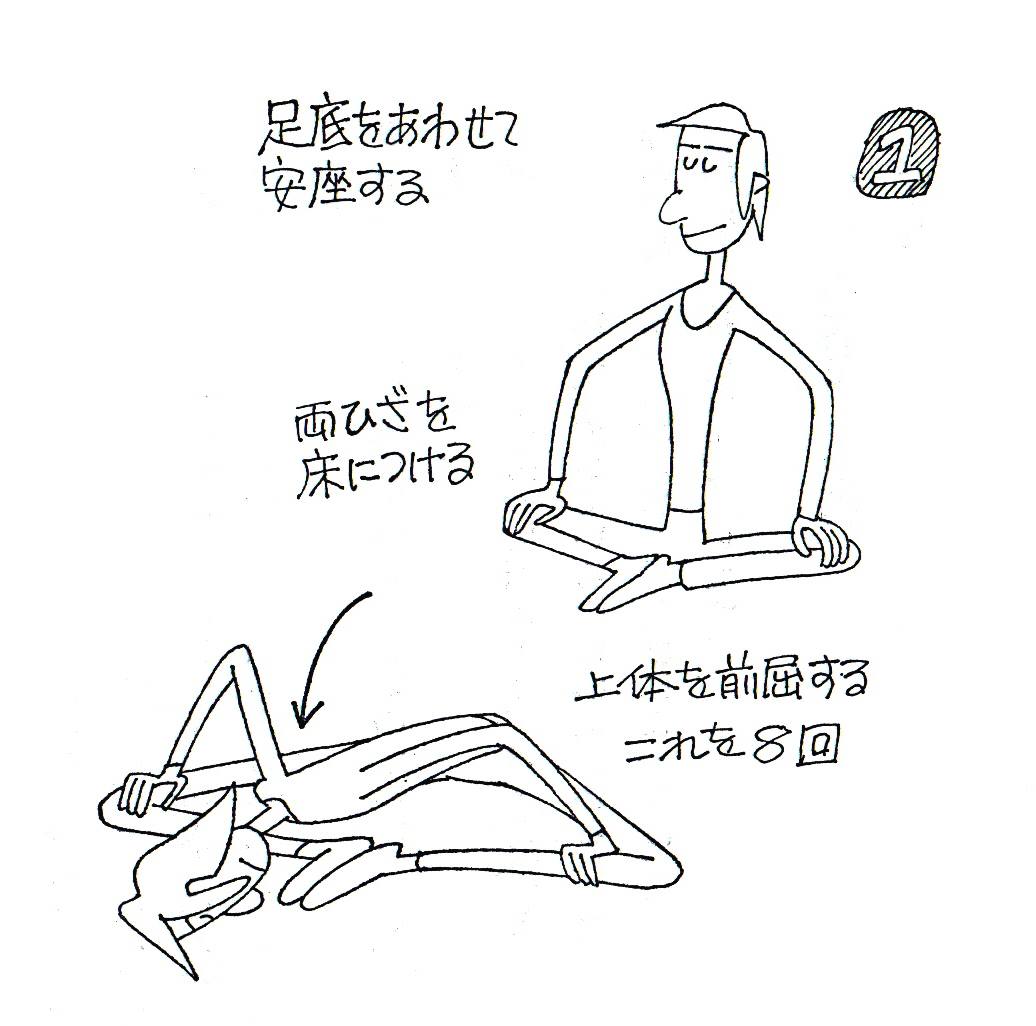
Seated Front Bend
Fig. 2 – With your legs extended to the front and your feet together grab hold of your toes. Bend your body forward from your waist. (Repeat this 8 times)
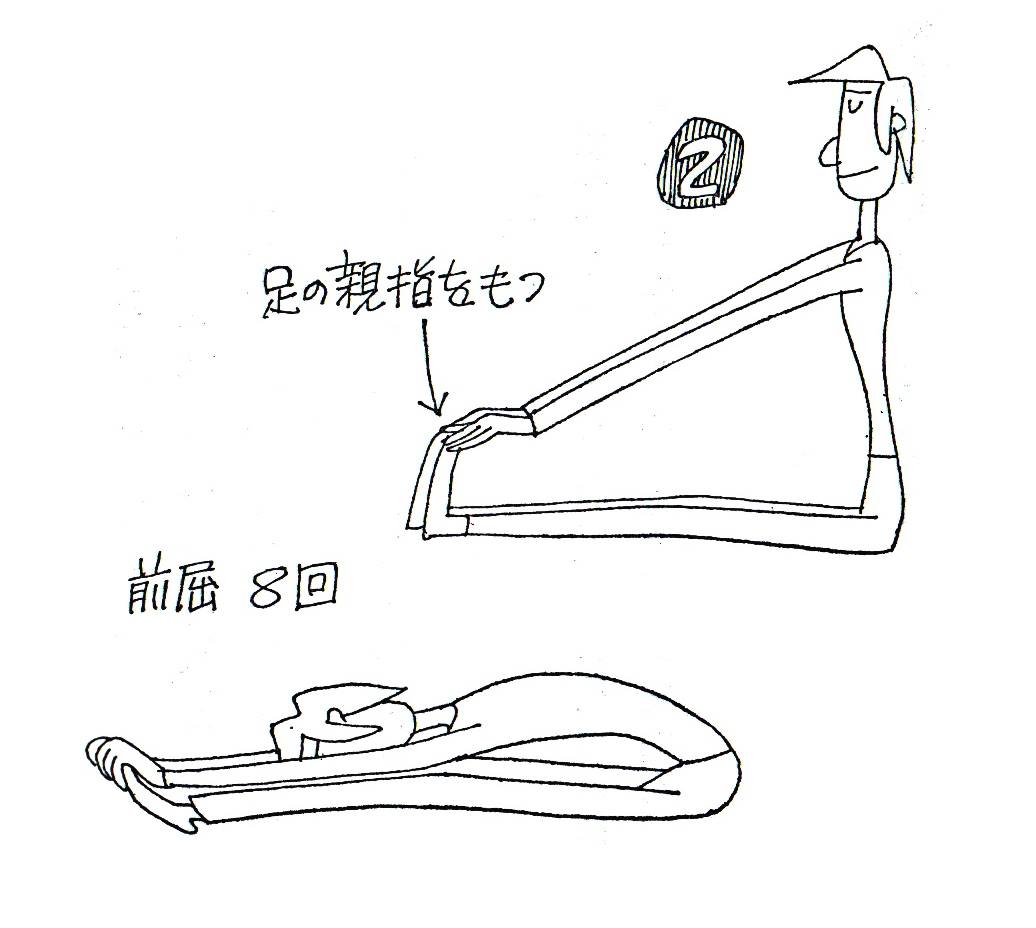
Seated Front Split
Fig. 3 – Open your legs wide and grab hold of your toes. Bend your body forward from your waist. Try to touch your chest to the floor. (Repeat this 8 times)
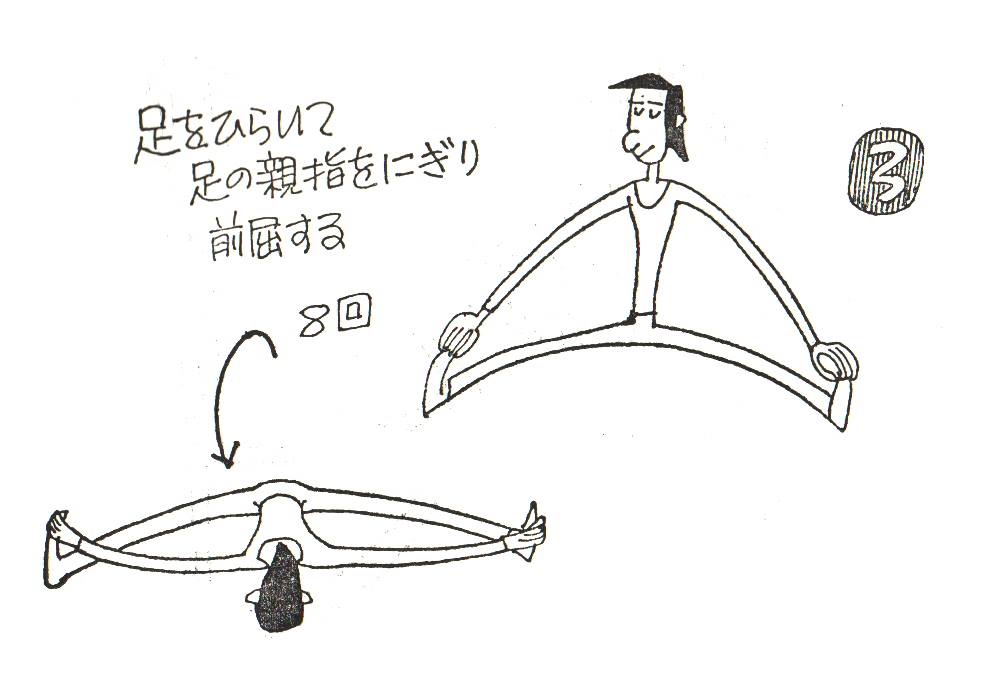
Seated Back Bend
Fig. 4 – Note: this exercise has two parts:
Part I – From a sitting position (Seiza) kneel upright halfway. Bend backward pushing your thumbs into the bottom of your feet. Keep your chest arched up in this table/bridge position. Then return to a sitting position (Seiza). (Repeat this 8 times)
Part II – Lie backward on the ground between your feet and relax there for at least 30 seconds.
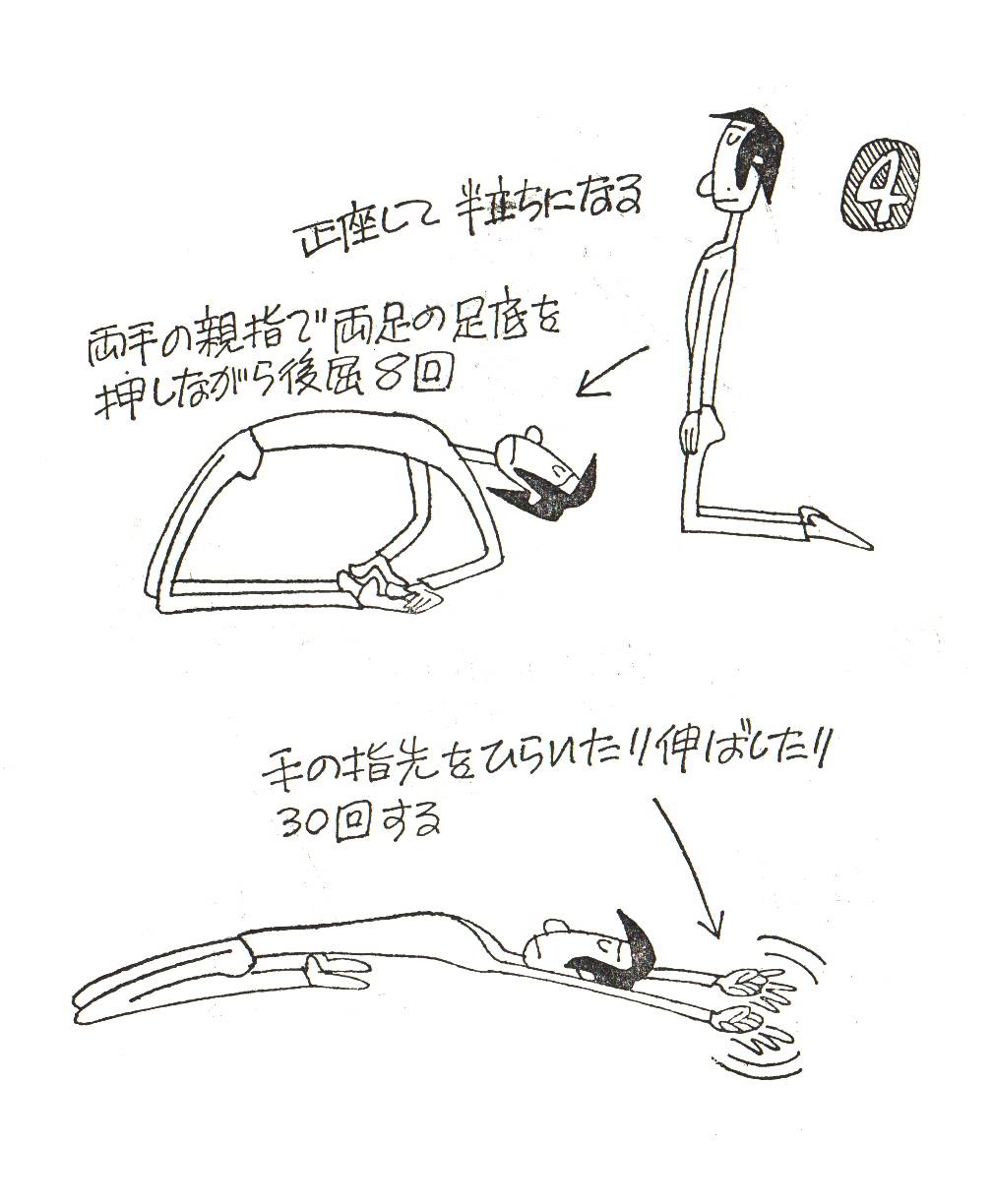
Ashi Furi 足振 (leg swinging)
Fig. 5 – Ashi Furi 足振 (leg swinging) From a standing position swing your right leg up:
- to the front 2 times
- to the side 2 times
- to the rear 2 times
Repeat this with your left leg.
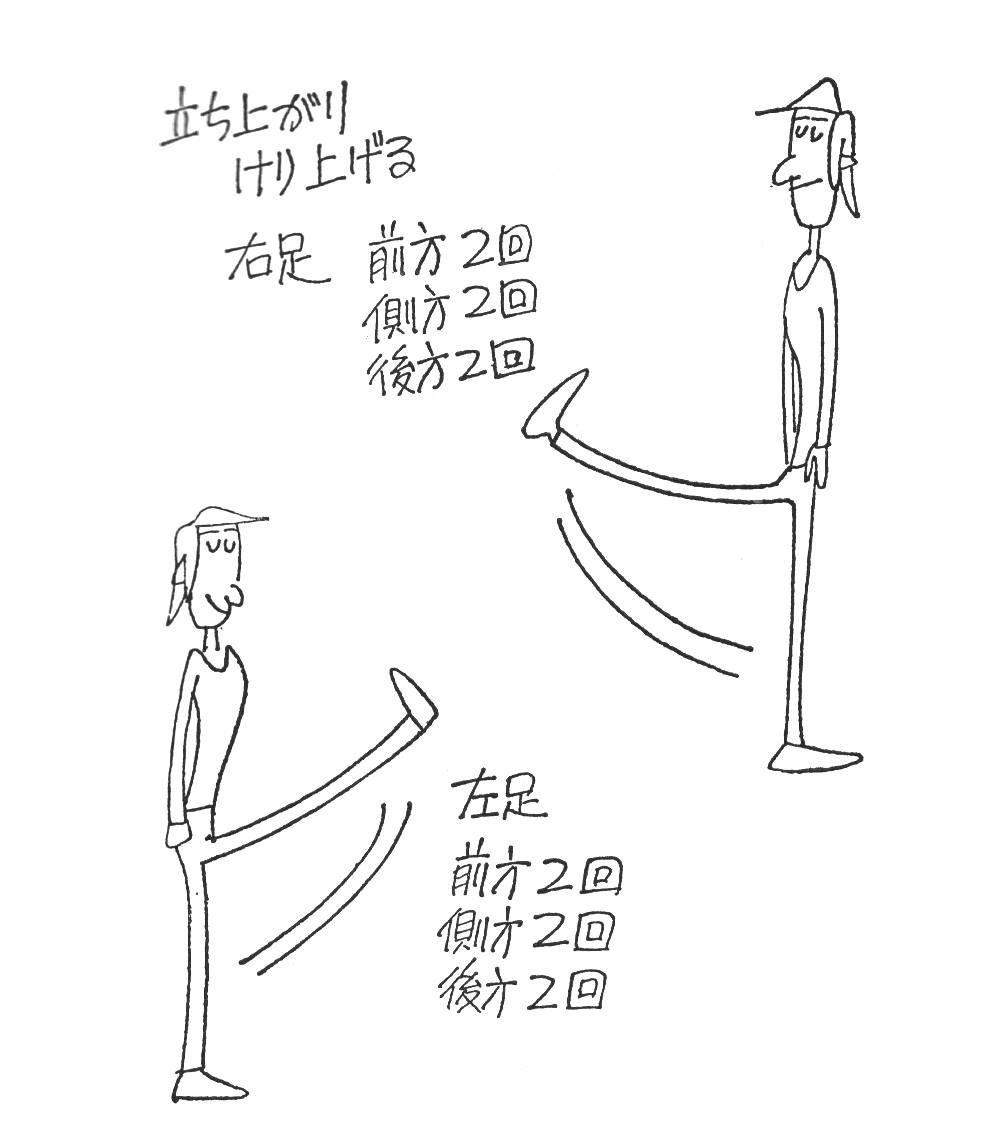
Shin Kokyū 深呼吸 (deep breathing) Three Methods
Fig. 6 – Shin Kokyū 深呼吸 (deep breathing) three methods:
- Shomen Kokyū Hō (forward deep breathing method) Seated in Seiza breath deeply as you expand your chest and pull both your shoulder back. (repeat this 8 times)
- Sayu Shin Kokyū Hō (left and right deep breathing method) Seated in Seiza turn your head to the right and inhale deeply pulling your right should back. (repeat this 8 times)
Turning your head to the left and inhale deeply pulling your left should back. (repeat this 8 times) - Shinten Shin Kokyū Hō (extended seat deep breathing method) Seated with your legs together extended to your front, spread your arms apart to your sides with your palms facing forward, inhale deeply. Exhale and place your hands down on your legs. (repeat this 8 times)
NOTE: Friction massage all over your body with the palms of your hands before training with the understanding that your entire skin (pores) breath: Hifu Kokyū 皮膚呼吸.
RELATED REFERENCE:
One should also reference the old article that I posted and translated titled:
Title: Ninja Kenkō-Hō Hi Sakusen Hichibuku Goshinjutsu 忍者 健康法 秘作戦 秘致武九護身術
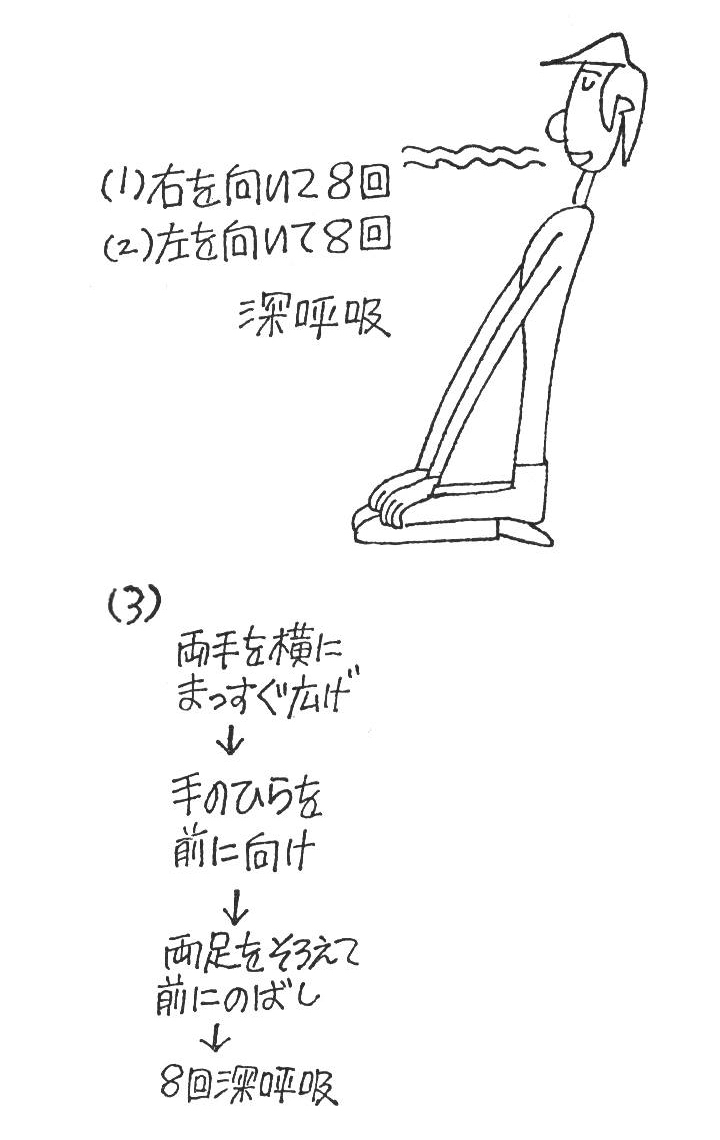
~ Glossary of Terms ~
- Bonnō 煩悩 (desires, attachments)
- Bunpisen 分泌腺 (endocrine glands)
- Byōgen 病源 (source of disease, the root)
- Eiyō 栄養 (nutrition)
- Hichibuku Goshinjutsu Genri 秘致武九護身術原理 is a sub-document contained within the larger document: (Nakatomi) Tatara Hibun 蹈鞴秘文. The treatments described in this chapter closely follow the contents of this document.
- Kanja 患者 (patient)
- Kokyūhō 呼吸法 (breathing methods)
- Saiminjutsu 催眠術 (hypnotism) – Sokusan Ho 速算法(fast calculation/divining method) a form of hypnotism for making the patient sleepy.
- Sanseika 酸性化 (acidification)
- Sejutsusha 施術者 (practitioner) also Jutsusha 術者 (practitioner)
- Seishin Ryōhō 精神療法 (psychotherapy)
- Seishin Tenka 精神転化 – (mental shift/transformation)
- Shōkaeki 消化液 (digestive fluid)
- Shokuyoku 食欲 (appetite)
- Tadashī Seishin 正しい精神 (correct spirit)
- Tamago no Shiromi 卵の白身 (egg whites) can also be written as Ranpaku 卵白
- Undō 運動 (movement exercise)
Disorders / Symptoms / Conditions
- Benpi 便秘 (constipation)
- Geri 下痢 (diarrhea)
- Kōketsuatsu-shō 高血圧症 (high blood pressure)
- Ikasui 胃下垂 (gastroptosis)
- Shinkeitsū 神経痛 (neuralgia)
- Shōka Furyō 消化不良 (indigestion)
- Yōtsū 腰痛 (backache)
Adjustments / Treatment Protocols
- I no Chōsei Riki Hō 胃の調整方法 (stomach adjustment method)
Anatomical Terms
- Kenkōkotsu 肩甲骨 (scapula bone of the shoulder)
Life Secrets of the Amatsu Tatara
The Documents of Takamatsu Toshitsugu
Interviews with Dr Hatsumi Masaaki
Purchase the book on Amazon: Buy the Book
www.amatsu-tatara.com
Following an extensive series of interviews and discussions between Peter King and Hatsumi Sensei, who is the Sōke (Head) of the Bujinkan Dōjō Organization, this book details the traditional medical methods that Dr Hatsumi inherited from his teacher Takamatsu Toshitsugu Sensei. It is Hatsumi Sensei’s wish that a record of these traditions continues into the future. This book covers a broad range of subjects relating to traditional medical and health methods used in Japan, and in particular their relationship to Budō (Martial Arts).
Containing numerous photographs of Hatsumi Sensei demonstrating these techniques in the Hombu Dōjō in Japan and transcripts of interviews with him, this book also provides a historical record of the Amatsu Tatara Hisshin Ginroku, which was written by Takamatsu Toshitsugu Sensei, now for the first time translated and published. It includes the spiritual aspects of the documents and an encyclopedic list of pathologies and historical natural treatments. (these documents fully translated into English and also shown in Japanese).
